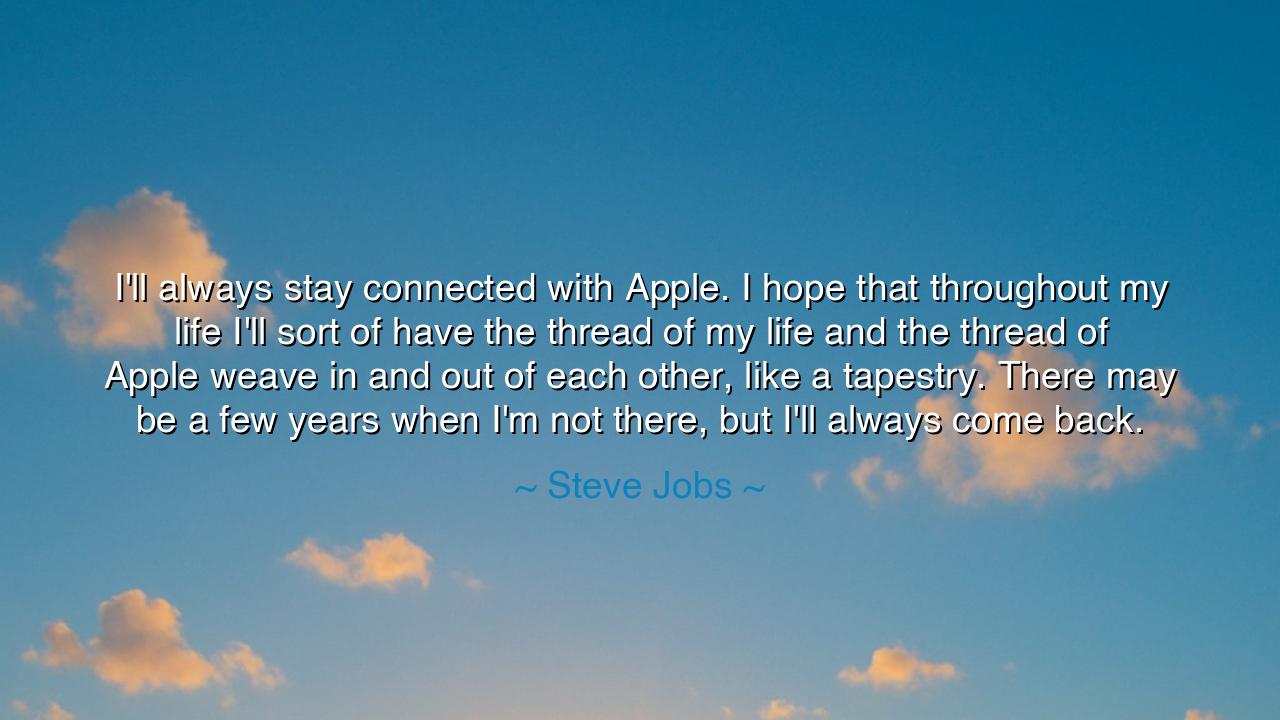
I'll always stay connected with Apple. I hope that throughout my
I'll always stay connected with Apple. I hope that throughout my life I'll sort of have the thread of my life and the thread of Apple weave in and out of each other, like a tapestry. There may be a few years when I'm not there, but I'll always come back.






When Steve Jobs said, “I’ll always stay connected with Apple. I hope that throughout my life I’ll sort of have the thread of my life and the thread of Apple weave in and out of each other, like a tapestry. There may be a few years when I’m not there, but I’ll always come back,” he was not merely speaking of a company, but of a calling—a bond between a creator and the creation that bore his spirit. His words are more than prophecy; they are the voice of a man who understood that the work of the heart is never finished, even when one is separated from it. For Jobs, Apple was not a business—it was a living reflection of his vision, a vessel through which his dreams of beauty, technology, and human creativity took form. His life and the life of Apple were threads of the same design, intertwined by destiny.
The origin of this quote lies in the years of Jobs’s early triumphs and later exile from the very company he founded. In 1985, after clashing with Apple’s board of directors, he was cast out from his own creation—a moment that could have broken a lesser man. Yet even in his absence, Jobs’s heart remained tethered to Apple. The tapestry he spoke of was already being woven: he would go on to found NeXT, nurture Pixar into brilliance, and ultimately return to Apple to lead it into a new golden age. His words proved prophetic, for he did return, and in his return, he changed the world once more. In this we see that true connection—born not of ownership, but of purpose and passion—can never be severed.
Jobs’s metaphor of threads weaving into a tapestry is ancient in its wisdom. For millennia, poets and philosophers have described life as a fabric woven by unseen hands. The Greeks told of the Fates, who spun, measured, and cut the threads of every life. In their loom, every joy, sorrow, and purpose formed a single grand design. Jobs, whether consciously or not, spoke from that same eternal understanding: that the story of a person and the work they love are interwoven, each giving meaning to the other. Just as a weaver cannot remove a single thread without marring the whole pattern, so too could Jobs not remove Apple from his identity. It was part of his story, his destiny, his very essence.
His life, indeed, reflected this truth. When he was gone from Apple, the company faltered; when he returned, it bloomed again, as though the missing thread had finally been restored to the loom. The story of his return in 1997 is not merely a tale of business—it is a parable of redemption, of persistence, and of the unbreakable bond between a creator and his creation. His return brought forth the iMac, the iPod, the iPhone—the fruits of vision realized. Each invention bore the mark of Jobs’s spirit, a spirit that fused art with engineering, imagination with discipline. It was as though, in coming home, he had restored the cosmic balance of his own tapestry.
But more deeply still, Jobs’s words teach that the threads of our lives are never meant to be straight. They twist, separate, and return, forming patterns we cannot see in the moment but which reveal meaning over time. There will be moments, as he said, when we step away from what we love—moments of exile, doubt, or loss. Yet if our passion is true, it will draw us back. The work of the heart, like the tide, returns again and again to the shore that shaped it. For those who follow their purpose, no separation is final. The thread of destiny may slacken, but it never breaks.
Consider the life of Michelangelo, who spent years battling with the Church and with his own frustration, yet always returned to the art that defined him. He painted and sculpted as if compelled by divine hand, even when he swore to abandon his craft. His ceiling in the Sistine Chapel was not just a commission—it was his spirit made visible in color and form. Like Jobs, his life was a dialogue with creation: sometimes distant, sometimes harmonious, but always intertwined. Both men knew that to create something truly lasting, one must give not just skill, but self, until the line between maker and masterpiece dissolves.
So, children of vision and craft, remember this: the thread of your purpose is sacred. It may waver, it may tangle, but it is yours alone to weave. Follow it with faith, even when the pattern is unclear. If you are separated from your dream, do not despair; what is woven in truth can never be lost. Life will guide you back, as it guided Steve Jobs, to the place where your passion and your purpose meet. For in the great tapestry of existence, every thread matters—but only those who weave with love create patterns that endure beyond their years. Let your life, like his, be one of return, renewal, and creation—and know that through your work, your spirit will never truly leave.






AAdministratorAdministrator
Welcome, honored guests. Please leave a comment, we will respond soon